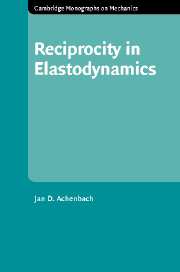Book contents
- Frontmatter
- Contents
- Preface
- 1 Introduction
- 2 Some elastodynamic theory
- 3 Wave motion in an unbounded elastic solid
- 4 Reciprocity in acoustics
- 5 Reciprocity in one-dimensional elastodynamics
- 6 Reciprocity in two- and three-dimensional elastodynamics
- 7 Wave motion guided by a carrier wave
- 8 Computation of surface waves by reciprocity considerations
- 9 Reciprocity considerations for an elastic layer
- 10 Forced motion of an elastic layer
- 11 Integral representations and integral equations
- 12 Scattering in waveguides and bounded bodies
- 13 Reciprocity for coupled acousto-elastic systems
- 14 Reciprocity for piezoelectric systems
- References
- Index of cited names
- Subject index
7 - Wave motion guided by a carrier wave
Published online by Cambridge University Press: 10 December 2009
- Frontmatter
- Contents
- Preface
- 1 Introduction
- 2 Some elastodynamic theory
- 3 Wave motion in an unbounded elastic solid
- 4 Reciprocity in acoustics
- 5 Reciprocity in one-dimensional elastodynamics
- 6 Reciprocity in two- and three-dimensional elastodynamics
- 7 Wave motion guided by a carrier wave
- 8 Computation of surface waves by reciprocity considerations
- 9 Reciprocity considerations for an elastic layer
- 10 Forced motion of an elastic layer
- 11 Integral representations and integral equations
- 12 Scattering in waveguides and bounded bodies
- 13 Reciprocity for coupled acousto-elastic systems
- 14 Reciprocity for piezoelectric systems
- References
- Index of cited names
- Subject index
Summary
Introduction
In this chapter we seek solutions to the elastodynamic equations that represent a combination of a carrier wave propagating on a preferred plane and motions that are carried along by that wave. The carrier wave supports standing-wave motions in the direction normal to the plane of the carrier wave. Such combined wave motions include Rayleigh surface waves propagating along the free surface of an elastic half-space and Lamb waves in an elastic layer.
The usual way to construct solutions to the elastodynamic equations of motion for homogeneous, isotropic, linearly elastic solids is to express the components of the displacement vector as the sum of the gradient of a scalar potential and the curl of a vector potential, where the potentials must be solutions of classical wave equations whose propagation velocities are the velocities of longitudinal and transverse waves, respectively. The decomposition of the displacement vector was discussed in Section 3.8.
The approach using displacement potentials has generally been used also for surface waves propagating along a free surface or an interface and Lamb waves propagating along a layer. The particular nature of these guided wave motions suggests, however, an alternative formulation in terms of a membrane-like wave over the guiding plane that acts as a carrier wave of superimposed motions away from the plane. For time-harmonic waves the corresponding formulation, presented in this chapter, shows that the carrier wave satisfies a reduced wave equation, also known as the Helmholtz or membrane equation, in coordinates in the plane of the carrier wave.
- Type
- Chapter
- Information
- Reciprocity in Elastodynamics , pp. 116 - 131Publisher: Cambridge University PressPrint publication year: 2004

